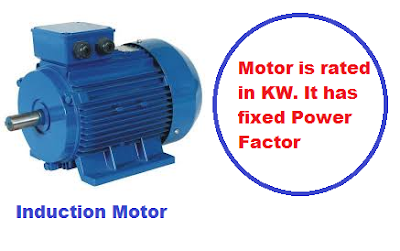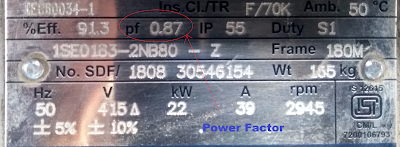A motor is rated in kilowatts (kW) because its primary purpose is to produce useful mechanical output power to drive a load. Kilowatts represent the active power—the power that does actual work—while kilovolt-amperes (kVA) represent the apparent power, which includes both active and reactive power. This is why you’ll often hear questions like “why motor rated in kW and transformer in kVA”—and the answer lies in how each device uses power.
Motor vs Transformer: Why the Rating Difference?
The induction motor and the transformer work on the same principle, that is, Faraday’s law of electromagnetic induction. The motor is rated in kW instead of KVA, and the transformer is rated in KVA instead of KW.
This rating difference lies in how each device uses and delivers power, which we’ll explore in the next sections.
Why Transformers Are Rated in kVA
The transformer and alternator are designed based on apparent power(kVA). The power factor at the incoming supply side of the transformer depends on the types of loads connected to the transformer’s secondary, i.e., the load may be resistive, inductive, or capacitive.
The designer does not know at what power factor the user will operate the transformer. Because of this uncertainty, transformer ratings are given in kVA, which covers all possible load types.
Read detailed article on: Why transformer rated in KVA, Not in KW?
Why Induction Motors Are Rated in kW

The motor’s load and power factor are fixed and known by the manufacturer. All the motor data—voltage, current, and power factor—are given on the motor’s nameplate. The motor is designed to drive the mechanical load of a particular rating.
The motor draws active and reactive power from the mains and converts active power it into mechanical power. The reactive power drawn by the motor to meet its magnetizing power requirement does not convert into useful work. This is why the motor’s rating is based on the useful power output.
Motor kW Rating and the Role of Active Power
The motor is designed to deliver the rated KW or the shaft power at the rated voltage, current, and power factor. When the motor is 100% loaded, it delivers the rated KW at the rated voltage, current, and power factor. The power factor is specified for the rated full load current of the motor.
The active power drawn by a three-phase induction motor is
P = KVA x Power Factor
P =√3 V I Cosφ
Where:
V = Line Voltage
I = Line Current
Cosφ = Power Factor
Motor Nameplate Data and kW Rating Explained
The following data is engraved on the induction motor’s nameplate, including the power factor specification

The motor is rated in KW as the voltage, current, and power factor is specified for the motor.
Conclusion
In short, motors are rated in kW because it represents the useful mechanical output power, while transformers are rated in kVA because their load power factor is unknown.
Related Articles:
1 thought on “Why Motor Rated in KW instead of KVA?”